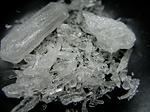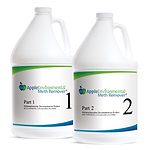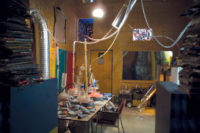The History of Meth & Future of Decontamination
As the need for meth cleanup grows, so does the ability to make a profit.


Crystal Meth

When doing meth lab cleanup and decontamination, you must have a product that can break down the chemical makeup of meth, not just a disinfectant or antimicrobial. This product is an example of something appropriate to use.



Methamphetamine is not a new drug, although it has become more powerful in recent years as techniques for its manufacture have evolved.
The History of Meth
According to DrugFreeWorld.org, Amphetamine was first made in 1887 in Germany and methamphetamine, more potent and easy to make, was developed in Japan in 1919. The crystalline powder was soluble in water, making it a perfect candidate for injection.
In the 1930s, doctors began using amphetamines in the United States to treat asthma and narcolepsy.
Methamphetamine went into wide use during World War II, when both sides used it to keep troops awake. High doses were given to Japanese Kamikaze pilots before their suicide missions. And after the war, methamphetamine abuse by injection reached epidemic proportions when supplies stored for military use became available to the Japanese public causing post-war Japan to experience the first meth epidemic.
In the 1950s, methamphetamine was prescribed as a diet aid and to fight depression. Easily available, "pep pills" or "bennies" were sold as a nonmedical stimulant to college students, truck drivers and athletes and abuse of the drug spread.
This pattern changed markedly in the 1960s with the introduction of home manufacturing of the drug, worsening the abuse.
Then, in 1970, the U.S. government added methamphetamine to the Controlled Substances Act regulating the drug. After that, American motorcycle gangs controlled most of the production and distribution of the drug.
During the 1980s, Mexican drug manufacturers began producing forms of the drug that could be smoked and towards the end of the decade, new ways to cook methamphetamine began to appear.
In the 1990s, Mexican drug trafficking organizations set up large laboratories in California. While these massive labs are able to generate 50 pounds of the substance in a single weekend, smaller private labs were springing up in kitchens and apartments, earning the drug one of its names, “stove top.” Rural locations became ideal for cooking meth because of geographic isolation.
Meth Today
Today, most of our meth in North America comes out of Mexico or is produced in soda bottles known as the "Shake n' Bake" method. Most of the contaminated properties become contaminated through usage rather than from production. It is estimated that more than 2.1 million Americans are currently using methamphetamine.
The problem is that users can contaminate anywhere from one to 50 properties per year, leading to an estimated 12 million properties contaminated in the U.S. and another 800,000 properties contaminated in Canada. Users move from house, to apartment, to hotel, to car, to new relationship, to the next motel, etc. Everywhere they go, they continue to use or smoke meth.
Nothing inside this drug is natural. Most of the ingredients contain carcinogens and poisons leaving a dirty trail behind that enters into the cold air returns circulating throughout the property. Studies indicate that just smoking meth two to four times can contaminate a property above habitable standards. Meth residue is sticky and clings to surfaces and inside the ducting system until it is physically decontaminated and removed.
The Decontamination Process
Here's a quick outline of the process:
- Remove Porous Materials
- Dry Clean
- Wet Clean
- Rinse
- Test
Decontaminating a property starts with removing all porous materials including furniture, carpet, carpet pad, soft ducts, etc. Next, the furnace and duct work is cleaned using duct cleaning equipment to remove dust, dirt, and debris.
Dust and dirt also needs to be vacuumed from the floor and surfaces throughout the property. Once everything has been dry cleaned, we bring up the heat and humidity in the home before applying a meth remover product. It is important to use a product that can remove the bio-film from the surface, making physical removal easier. The product can be applied with a ULV fogger, foamer (most recommended) or a paint sprayer. Once product is on the surfaces, scrub it into the surfaces and allow to remain moist up to four hours. This process is repeated two to three times depending on the amount of methamphetamine in the property.
Lastly, we rinse. The meth remover product rinses easily with water. Once the surfaces are dry, the home is ready for testing.
There are less than 1,000 remediation companies that actually advertise that they remediate methamphetamine and there are nearly 12 million contaminated properties in North America. This means our industry could easily add another 20,000 remediation companies that could complete 50 to 100 jobs a year.
The best part about meth remediation is that there are no such things as meth emergencies. Meth remediation calls aren’t made in the middle of the night and the jobs can be scheduled. Contrast this with water damage work. The profit margins are good (35-55% depending on your efficiency). This problem is not going away.
For Additional Training
Apple Environmental, in conjunction with Interlink Supply and Aramsco, will be traveling across the U.S. to teach one day courses on proper decontamination, testing, marketing and product best practices. The courses will be taught at the various Interlink Supply, Aramsco stores throughout the United States. We’ve taught over three hundred and twenty different companies over the past four years in the U.S., Canada, Australia and New Zealand while operating our own decontamination service company. We look forward to teaching hundreds more over the next few years as we need more good companies in this industry.
Come be part of a growing industry.
Looking for a reprint of this article?
From high-res PDFs to custom plaques, order your copy today!










